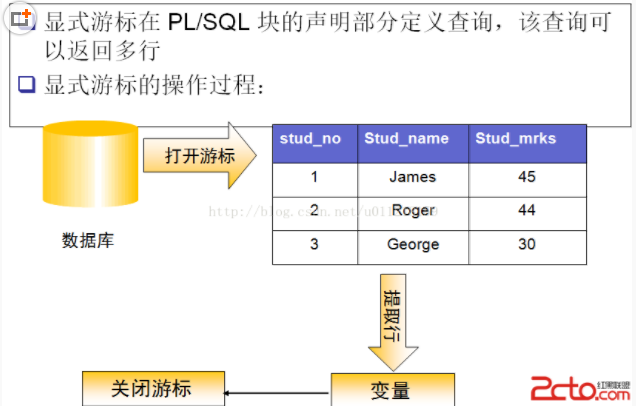一、游标的相关概念:
定义:
游标它是一个服务器端的存储区,这个区域提供给用户使用,在这个区域里
存储的是用户通过一个查询语句得到的结果集,用户通过控制这个游标区域当中
的指针 来提取游标中的数据,然后来进行操作。

实质:
是用户在远程客户端上对服务器内存区域的操作,由数据库为用户提供这样的
一个指针,使得用户能够去检索服务器内存区的数据。
(1)、 指向上下文区域的句柄或指针
(2)、上下文区域-用于SQL处理的内存区
(3)、上下文区域的内容
- 语句处理的行数
-指向语句的语法分析表示的指针
二、游标的类型
a)静态游标
- 隐式游标
- 显式游标
b)Ref游标
三、游标具有的属性
%notfound 询问是否没有结果集
%found 询问是否存在结果集
%rowcount 返回受影响的行数
%isopen 询问游标是否已经打开
四、隐式游标
隐式游标 ---由Oracle数据库自动创建,名称是(SQL) ,主要用途是可以返回一个操作是否成功或失败.
1.有Oracle在内部声明,由系统管理
2.用于处理
-DML语句 --注意只能用于DML语句哦。
-返回单行的查询
3.用于判断一个操作是否成功.
SQL%notfound --返回Boolean值 存在结果集返回 False
SQL%found --返回Boolean值 存在结果集返回 True
SQL%rowcount --用户成功提取数据的行数
SQL%isopen --在隐式游标里一般这个属性是自动打开和关闭的.且任何时候查询都返回False
示例:向表中插入一行数据,询问是否插入成功.
declare iCount int:=0; begin insert into place values(2,'beijing'); DBMS_output.put_line('游标所影响的行数:'||SQL%rowcount); if SQL%NotFount then DBMS_output.put_line('NotFount为真); else DBMS_output.put_line('NofFount为假'); end if; if SQL%Fount then DBMS_output.put_line('Fount为真); else DBMS_output.put_line('Fount为假'); end if; if SQL%isopen then DBMS_output.put_line('isOpen为真); else DBMS_output.put_line('isOpen为假'); end if; isCount:=SQL%rowcount; DBMS_output.put_line('影响了'||isCount||'行'); end;



显示游标:

SQL> declare 2 --定义游标类型sp_test_cursor 3 type sp_test_cursor is ref cursor; 4 --定义一个游标变量 5 test_cursor sp_test_cursor; 6 --定义变量 7 v_name mytest.name%type; 8 v_passwd mytest.passwd%type; 9 begin 10 --执行 把cursor和一个select结合 11 open test_cursor for select name,passwd from mytest; 12 loop 13 fetch test_cursor into v_name,v_passwd; 14 --跳出循环的条件即判断当前游标是否为空 15 exit when test_cursor%notfound; 16 dbms_output.put_line('name:'||v_name||' passwd:'||v_passwd); 17 end loop; 18 --关闭游标 19 close test_cursor; 20 end; 21 / name:123 passwd:123 name:gaodingle!!!! passwd:123 name:gagaga passwd:123 name:125555 passwd:passwd PL/SQL procedure successfully completed SQL> declare 2 type sp_cursor is ref cursor; 3 test_cursor sp_cursor; 4 v_id mytest.id%type; 5 v_name mytest.name%type; 6 v_passwd mytest.passwd%type; 7 v_salary mytest.salary%type; 8 begin 9 open test_cursor for select id,name,passwd,salary from mytest; 10 loop 11 fetch test_cursor into v_id,v_name,v_passwd,v_salary; 12 if v_salary=100 then 13 update mytest set salary=v_salary+50 where id=v_id; 14 end if; 15 exit when test_cursor%notfound; 16 end loop; 17 close test_cursor; 18 end; 19 / PL/SQL procedure successfully completed SQL> select * from mytest; ID NAME PASSWD SALARY ----- -------------------- -------------------- -------------------------------------------------------------------------------- 1 123 123 150 2 gaodingle!!!! 123 150 3 gagaga 123 150 4 125555 passwd 50